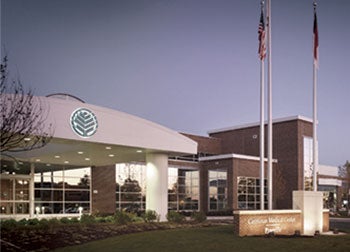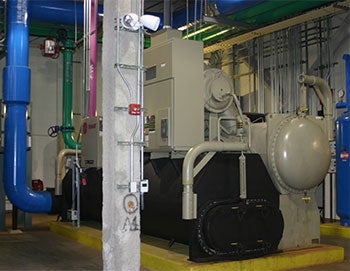N.C. hospital reduces energy use by 26 percent
 |
| Photo courtesy of Carolinas HealthCare System Carolinas HealthCare System-Pineville was one of four Carolinas HealthCare System hospitals to receive an Energy to Care Award. |
Carolinas HealthCare System –Pineville, Charlotte, N.C., is a 479,000-square-foot acute care hospital that at one time was notable within its system of health care facilities for the wrong reasons.
In 2014, the 206-bed hospital ranked as the worst energy performer in the 40-hospital Carolinas HealthCare System (CHS). Thanks to a strategy that combined data-based energy measuring, the implementation of several tried-and-true, low-cost energy saving actions and some capital improvements, Pineville has reduced its energy consumption by more than 26 percent in 18 months.
The hospital also benefited from energy-saving programs offered by the American Society for Healthcare Engineering (ASHE), which recognized Pineville and 22 other medical facilities nationwide for significantly cutting energy consumption. Pineville was one of four Carolinas HealthCare System hospitals to receive an ASHE Energy to Care Award for its work in slashing energy use.
The road to improved energy-efficiency at Pineville began in 2012 when the Carolinas HealthCare System facilities management group (FMG) set a goal to reduce energy use intensity (EUI) — defined as energy use per square foot per year — by 20 percent.
 |
| Photo courtesy of Carolinas HealthCare System Energy-efficiency improvements included upgrading chilled water systems and installing occupancy sensors. |
Twelve key facilities were designated to achieve the reduction over a five-year period ending December 2017. The plan encompassed Pineville, seven other acute care facilities, two nursing homes and two rehabilitation facilities.
To put its goals within reach, the Carolinas HealthCare System FMG invested in both physical improvements at facilities in the portfolio as well as infrastructure to drive change. The FMG partnered with a national energy consulting firm to perform energy audits at Pineville and the other facilities.
The FMG team identified and secured funding for a series of energy projects with capital investments that could be offset quickly through savings and then applied across the portfolio of facilities.
The projects included retrocommissioning, installation of setback controls in specialized ventilation rooms, upgrading chilled water systems and retrofitting variable air-volume terminals from pneumatic control to direct digital control.
While the capital projects are an important part of the story, the energy performance improvements at Pineville began well before the capital projects through the use of operational improvements that were implemented.
Joe Ross joined Carolinas HealthCare System in early 2014 as plant operations and maintenance manager at Pineville and was charged with the task of leading the energy-reduction effort.
Ross and his team discovered low-hanging fruit — multiple opportunities to cut energy use starting with lighting. A sophisticated lighting control system installed in the kitchen and dining areas had never been programmed, and incandescent light bulbs were used in patient room lamps instead of LEDs. Both situations were resolved quickly.
A perception that installing occupancy sensors was costly and complex prevented some FMG team members from embracing the technology. To change that, facilities staff instituted a pilot project to install a 10-year life, battery-powered occupancy sensor in a small area within the hospital that proved successful.
Ross’s team identified kitchen area systems and equipment routinely left on during periods of inactivity. The effort prompted cross-departmental collaboration and built rapport among staff as they worked toward cutting energy use.
Ross determined that one entire hospital wing was heating water to 140 F for the sole purpose of servinga dishwasher in the kitchen. Heating water to 140 F wasted energy as it was blended with cold water to reduce the temperature back down to the commonly used 115 F for other functions.
The facility team installed a point-of-use booster heater at the dishwasher, allowing the building’s water heater to be set at 115 F, while still providing the higher temperature to the dishwasher.
The largest energy impact resulted from adjusting the HVAC occupancy schedules and reducing simultaneous heating and cooling. Air-handling units typically were set to a constant supply air temperature (typically 55 F) only to be reheated at the zone level. Ross’s team began increasing the supply air temperature until there was less need for zone reheating.
ASHE’s Energy to Care program provided a complimentary energy dashboard that helped the Carolinas HealthCare System FMG to track energy consumption and savings systemwide as well as allow each facility to track its individual progress.
Ross calculated unadjusted power and gas consumption to see data changes daily, monthly and yearly. The measurement and analysis process also extended to fan speeds, air and water pressures and temperatures on large systems.
Pineville’s second phase of work, launched about a year ago, entailed larger, capital-intensive improvements. In less than five months, Pineville decreased its EUI by an additional 10 percent over the 16 percent gains made through active local management.
This additional 10 percent reduction was the direct result of retrocommissioning performed as specified in the ASHE Health Facility Commissioning Guidelines and Health Facility Commissioning Handbook.
Read the full case study on Pineville’s energy-saving success from ASHE’s Energy to Care program.




